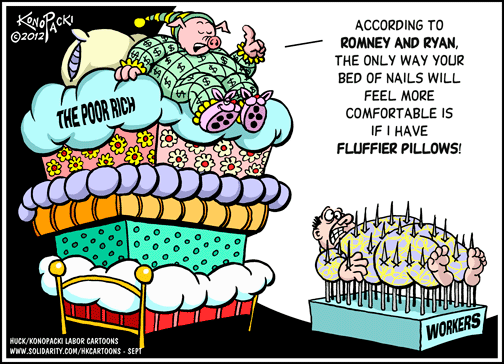California’s
Proposition 32, on the November ballot, has been dubbed the Stop Special
Interests initiative. In reality, it is targeted at the state’s unions, with
the goal of preventing them from using payroll deductions to fund their
political campaigns and lobbying. The bill would have virtually no effect on
private businesses or corporate lobbying, as private businesses do not raise
political funds through payroll deductions.
The campaign in
support of 32, not surprisingly, has been heavily funded by corporate interests
that hope to stifle unions’ political involvement, which is already miniscule
compared with theirs. Yet even their small involvement in politics is
unacceptable to the wealthy, who would like to see the unions, as well as any
workplace and environmental protections, disappear completely.
One of the major
funders of Prop 32 is the American Future Fund, a Super PAC affiliated with the
Koch Brothers and Karl Rove, which recently contributed $4 million from secret
donors to the campaign. Prop 32 is also backed by Democrats for Education
Reform (DfER), an anti-union and anti-teacher organization that is funded by
hedge fund managers and Wall Street brokers.
While the backers of 32 have been very deceptive
in their promotion of this legislation, inaccurately suggesting that the bill
would stop all special interests from influencing politics, the unions
themselves have engaged in a deceptive, top down and undemocratic campaign to
defend themselves. For example, representatives of the California Teachers
Association (CTA) have told members the bill would end collective bargaining
rights for them. However, Prop 32 says nothing about unions’ right to
collectively bargain and if it passes it would have no direct effect on
collective bargaining. Nevertheless, it is safe to assume that the bill’s
backers would like to end collective bargaining, and that passage of the bill
would facilitate this goal by stifling unions’ ability to lobby in defense of
collective bargaining.
It is also probably
safe to assume that most union members would oppose 32 if educated about it and
that they would support their unions’ efforts to resist it. However, the CTA’s
decision to prioritize the anti-32 campaign (and the pro-30 tax increase
campaign) over virtually all other activities was essentially made from the
top-down, with very little input from the rank and file. This approach has the
potential to alienate and anger members, rather than encourage their support
and participation.
Furthermore, the way
the CTA engaged the locals to participate in their campaigns has been
autocratic and coercive. In my local, for example, our CTA representative told
us we “had to” participate in the CTA activities around these two initiatives
and we “did not” have a choice in the matter. To make matters worse, we were
expected to carry out some of these activities during the same week we had to
vote on a new contract, adding an unnecessary degree of confusion, anxiety and
frustration to our members, who were already overburdened with their normal
teaching responsibilities, and to our organizers and representatives
responsible for carrying out these two unrelated union duties.
Of course it will be
devastating to students and teachers if 30 loses and 32 wins. K12 and higher
education will lose $6 billion in funding, while the corporate education reform
movement will gain considerably more political power to further gut public
education. Yet one the reasons why corporate interests have gained so much
political power in recent years is that unions have relinquished their most
powerful weapon—direct action—in favor of going toe to toe with the wealthy in
the political arena. Even without Citizens United, corporations were able to
outspend unions by large margins. And even without outspending them, policy
will almost always come down in favor of the wealthy and their businesses
because the politicians are members of the same class and their economic
interests lie more with their corporate friends and allies than with the rest
of us.
The unions argue that
their funding of political campaigns and lobbying have led to important gains
for teachers and this is partly true. However, this does not mean that
political action is the only or even most effective tactic. And despite these
gains, real wages and benefits have been declining steadily for decades. Class sizes have been
soaring. Programs continue to be cut. Working hours have increased. And perhaps
most devastating to teachers’ living conditions, the unions have completely
failed to do anything substantive about rising health care costs, with the
result that workers must pay more and more out of pocket for health coverage
each year, a cost that further erodes take home pay.
Workers’ real power
lies in their ability to withhold their labor, and this is only effective when
workers are well-educated and organized. Ironically, a well-organized and
educated membership can also easily be mobilized to engage in canvassing, phone
banking, letter writing, fundraising and other political activities,
potentially with greater effectiveness than can be achieved through union-hired
lobbyists and campaign managers. However, the ultimate goal should always be
job actions, including General Strikes, as these have the greatest potential to
force bosses and politicians to buckle to workers’ demands. This sort of
organizing needs to be initiated from
the bottom up and, to be effective, must empower workers, not make them feel
like minions of their unions.








